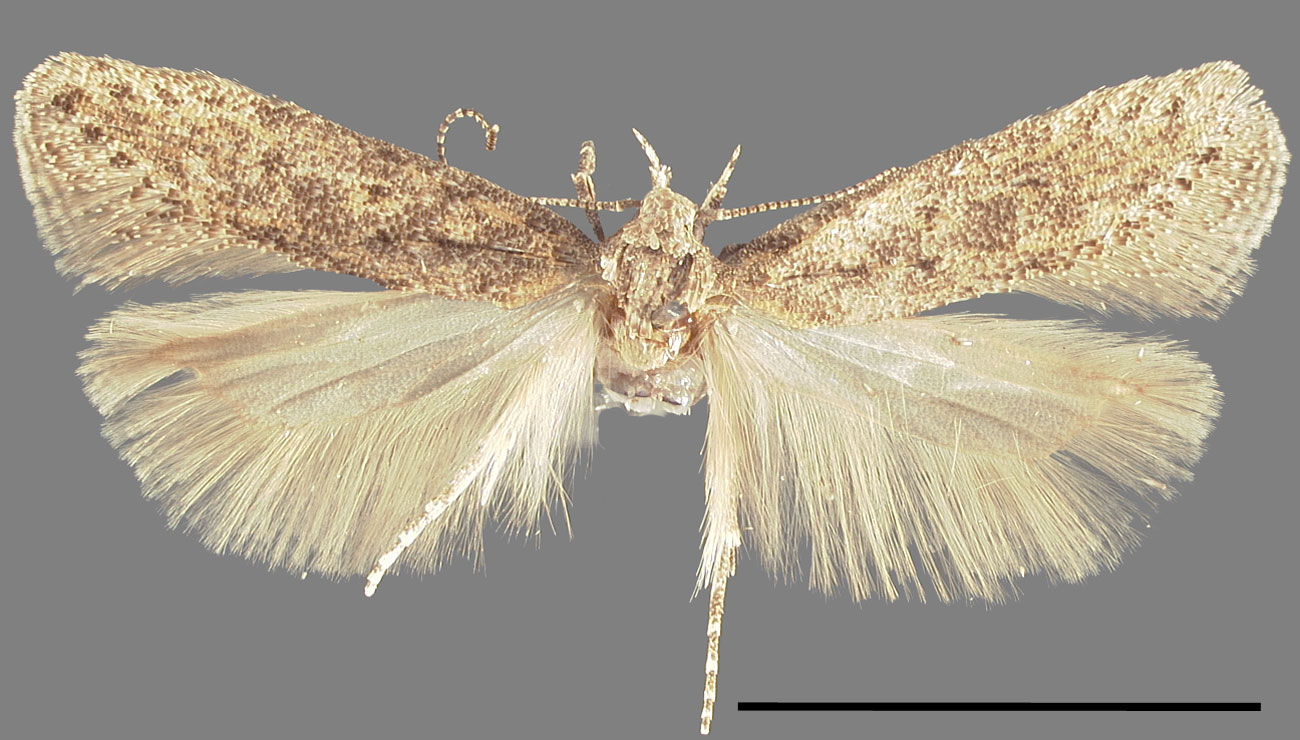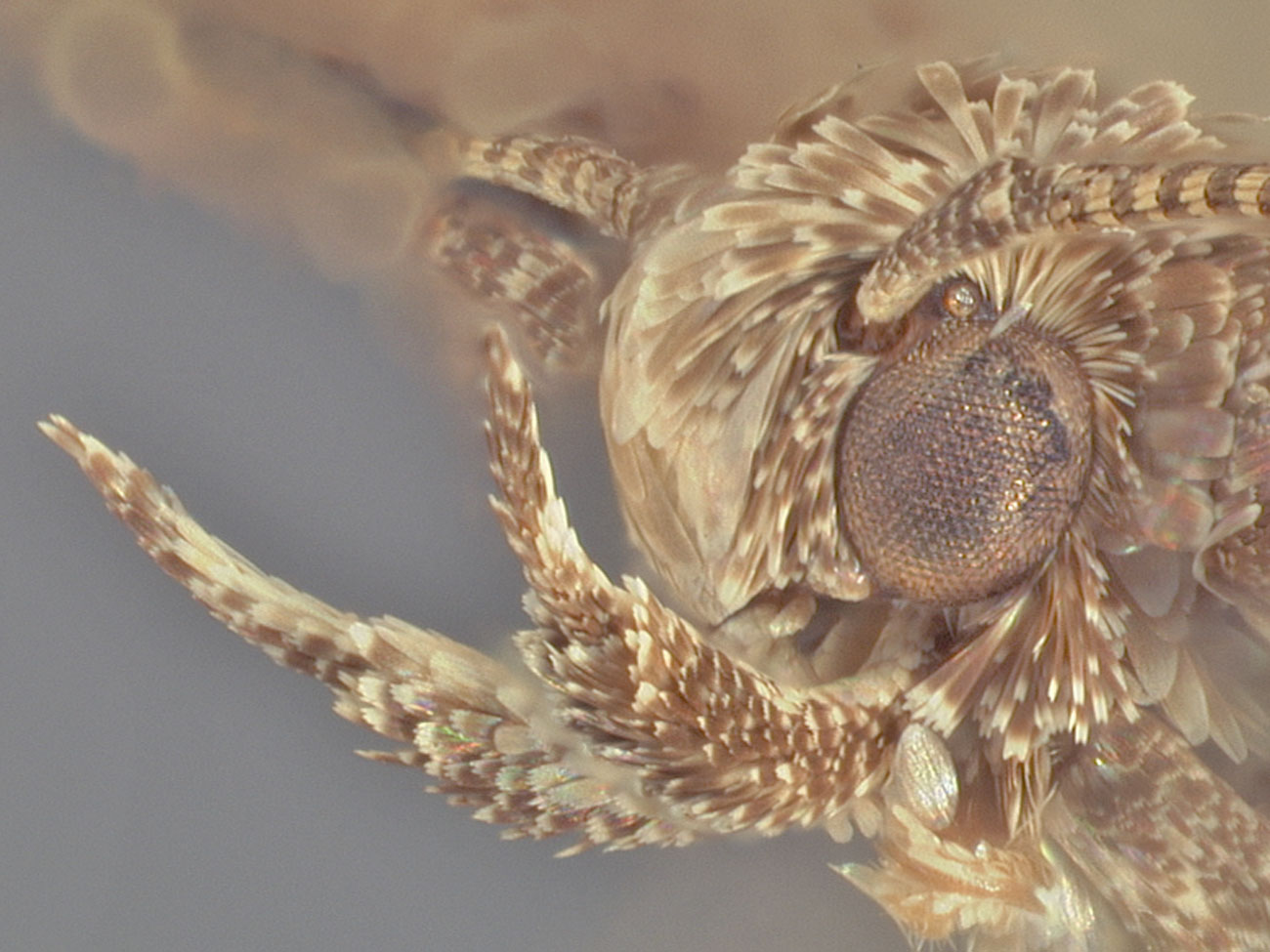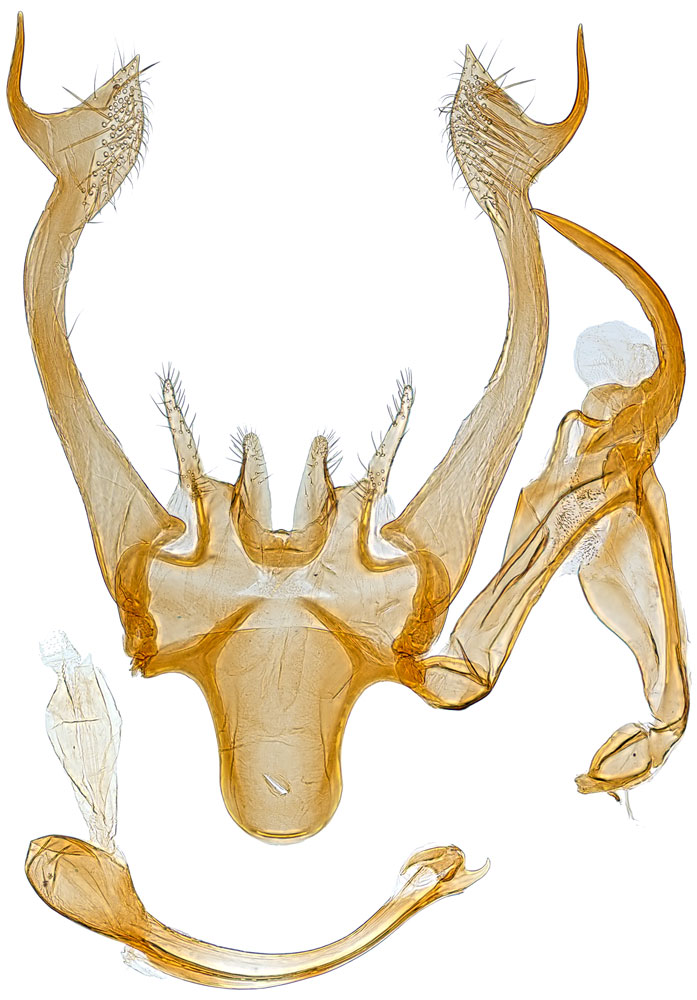Keiferia altisolani
|
Keiferia altisolani habitus of paratype (NMNH). Scale = 5 mm. |
|
Keiferia altisolani head. |
|
Keiferia altisolani male genitalia. |
|
Keiferia altisolani female genitalia. |
Name
Keiferia altisolani (Keifer, 1937)
Common name: none
Original combination: Gnorimoschema altisolani Keifer, 1937
Synonyms: none
Classification: Gelechioidea: Gelechiidae: Gelechiinae: Gnorimoschemini
Adult recognition
Adults are about 5.0–6.0 mm in forewing length. They are gray, mottled with light and dark gray, and the apex of the wing has yellowish-orange lines. The labial palpusLabial palpus:
The more prominent, elongate pair of appendages on the head, usually three-segmented (pl. palpi).
-800px.jpg) is upturned. The hindwing is light gray and trapezoidal, with hair-pencils above from the base of the costal margin in males. The male genitalia have a slender sickle-shaped uncusUncus:
is upturned. The hindwing is light gray and trapezoidal, with hair-pencils above from the base of the costal margin in males. The male genitalia have a slender sickle-shaped uncusUncus:
The prominent projection from the dorsal tegumen of the male genitalia. May be variously shaped as a hook, knob, hood, etc.
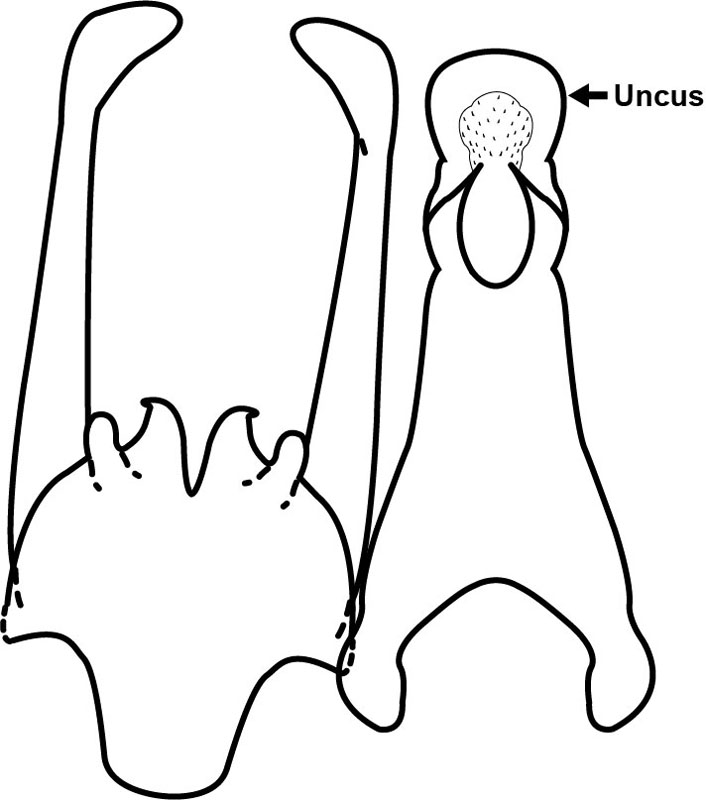 , and the elongate valvaValva:
, and the elongate valvaValva:
One of the pair of large lateral appendages of the male genitalia (pl. valvae).
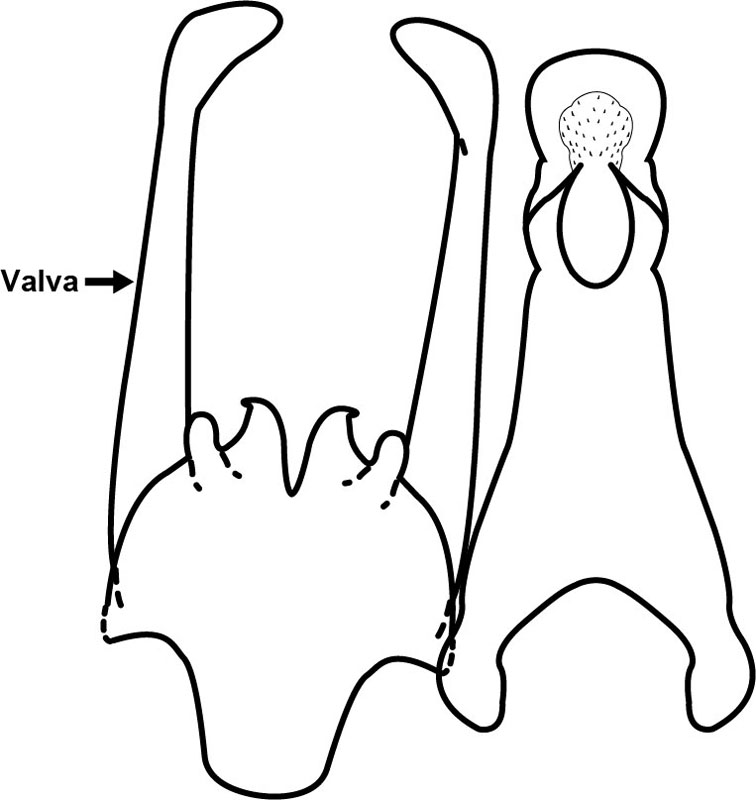 has a large sickle-shaped bifurcation at the apex. Females have the ostium with elongate, oblong sclerotization and a large sickle-shaped signumSignum:
has a large sickle-shaped bifurcation at the apex. Females have the ostium with elongate, oblong sclerotization and a large sickle-shaped signumSignum:
Any sclerite, sclerotized area, or discrete granular area on the wall of the corpus bursae (pl. signa).
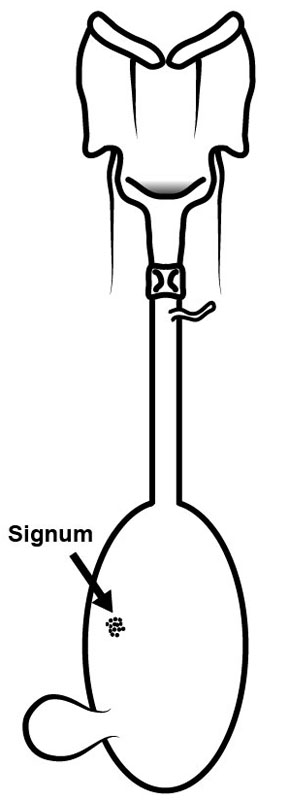 with base protruding outside of the bursa wall.
with base protruding outside of the bursa wall.
Immature stages
Larvae when fully grown are 8.0–8.5 mm long. The head is blackish, flattened, partly retracted, the epicranial halves extended farther to the rear than usual resulting in the fronsFrons:
The front of the head, between the eyes.
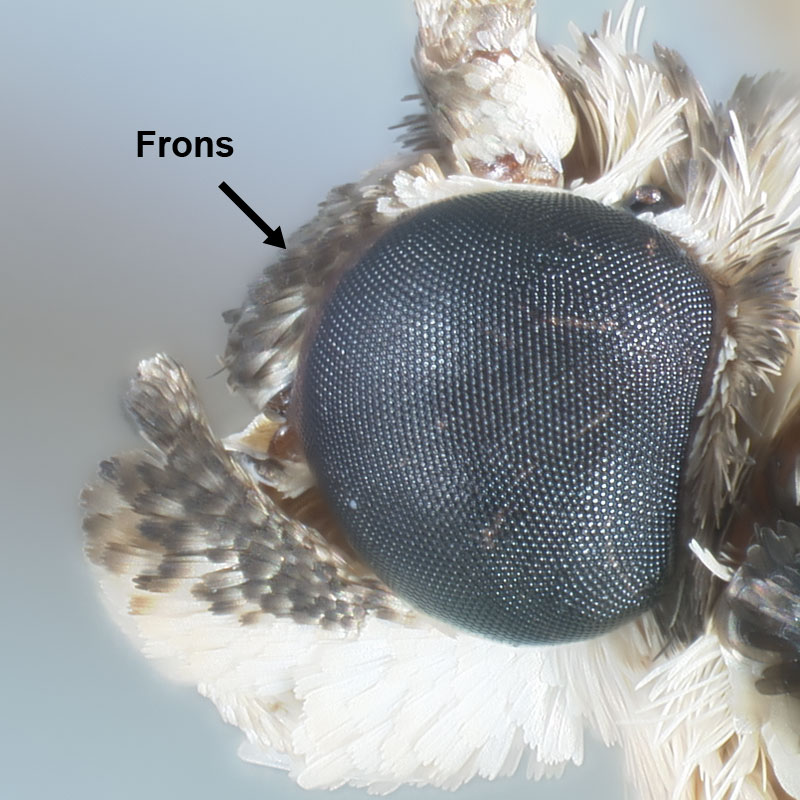 being little over half as long as epicranium. The prothoracic shieldProthoracic shield:
being little over half as long as epicranium. The prothoracic shieldProthoracic shield:
Also called the T1 shield. In the larva, the extensive sclerotized area of the dorsal half of the prothorax. It bears six setae on each side, and its color pattern is often diagnostic.
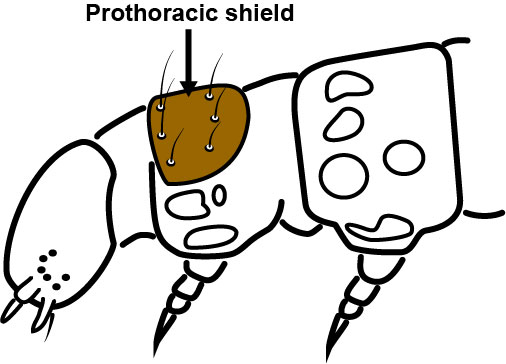 lacks a posterior band; the pinacula are rather small and blackish and the anal shield is dark. The body is flattened, tapering, varying from rather strong shade of green to bluish-purple, often with anterior half purple, the remainder green.
lacks a posterior band; the pinacula are rather small and blackish and the anal shield is dark. The body is flattened, tapering, varying from rather strong shade of green to bluish-purple, often with anterior half purple, the remainder green.
PDF - Dichotomous key to Gelechiid larvae
Similar species
Keiferia altisolani is allied to Keiferia lycopersicella, K. glochinella and K. inconspicuella. This species is recognized by the forewing size and color, being somewhat larger and grayer than
K. lycopersicella, and the unique elongate male valvaValva:
One of the pair of large lateral appendages of the male genitalia (pl. valvae).
 with large bifid apex that is absent from K. lycopersicella, K. glochinella or K. inconspicuella.
with large bifid apex that is absent from K. lycopersicella, K. glochinella or K. inconspicuella.
Keiferia altisolani has a retracted flattened head, distinctive hostplant, and limited distribution (California). The larva differs from K. lycopersicella in lacking a band on the prothoracic shieldProthoracic shield:
Also called the T1 shield. In the larva, the extensive sclerotized area of the dorsal half of the prothorax. It bears six setae on each side, and its color pattern is often diagnostic.
 and in possessing crochetsCrochets:
and in possessing crochetsCrochets:
Tiny, hook-like, sclerotized setae on the abdominal and anal prolegs of larvae. 'Uni-,' 'bi-,' and 'triordinal' refer to the relative sizes of crochets (one, two, or three different sizes).
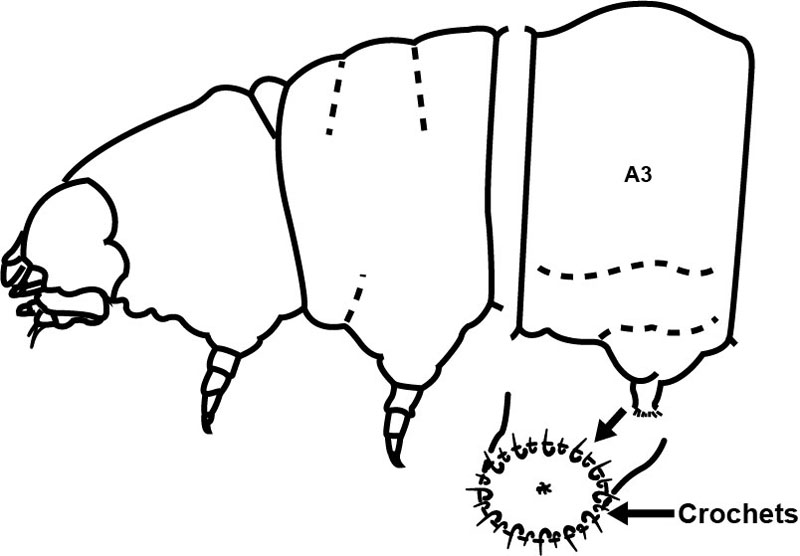 in a complete circle on A3-6. In addition, the body microspines are more than twice as long as in K. lycopersicella. The trisetose L group on A9 in K. altisolani seperates it from Symmetrischema tangolias that has the L group bisetose.
in a complete circle on A3-6. In addition, the body microspines are more than twice as long as in K. lycopersicella. The trisetose L group on A9 in K. altisolani seperates it from Symmetrischema tangolias that has the L group bisetose.
Behavior
Larvae may spend their entire life mining leaves or in other cases they may tie them together. Both the mines and leaf ties have a "baggy appearance".
Distribution
Native to North America. USA (California).
Hosts
Solanum xanti A. Gray (Chaparral nightshade)
Comments
Although this species is known only in the southwestern United States and so far is not present in Florida and the Gulf Coast, it is mentioned here because the wing pattern and size of this species are very similar to those of eastern non-target or target species of Keiferia.
Literature
Keifer 1937Keifer 1937:
Keifer HH. 1937. California Microlepidoptera XI. Bulletin of the Department of Agriculture, State of California 26: 177-204.
Hodges 1985Hodges 1985:
Hodges RW. 1985. A new species of Tildenia from Illinois (Gelechiidae). Journal of the Lepidopterists#39; Society 39: 151-155.
Powell and Povolný 2001Powell and Povolný 2001:
Powell JA and Povolný D. 2001. Gnorimoschemine moths of coastal strand and dune habitats in California (Gelechiidae). Holarctic Lepidoptera 8 (Suppl. 1): 1–51, 115 figs., 8 color.

